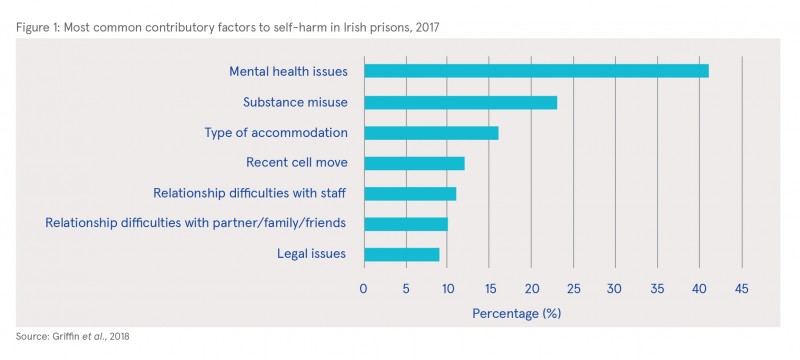Millar, Sean (2019) Self-harm in Irish prisons. Drugnet Ireland, Issue 71, Autumn 2019, pp. 22-23.
| Preview | Title | Contact |
|---|---|---|
|
PDF (Drugnet 71)
1MB |
There are 12 institutions in the Irish prison system, comprising 10 traditional ‘closed’ institutions and two open centres, which operate with minimal internal and perimeter security. The majority of female prisoners are accommodated in the purpose-built Dóchas Centre adjacent to Mountjoy Prison in Dublin, while the remainder are located in a separate wing of Limerick Prison. Self-harm and suicide are major issues in the prison population, as rates of suicide and lifetime self-harm are higher in prisoners compared with the general population. The rate of suicide in Irish prisons from 2011 to 2014 was 47 per 100,000 prisoners. However, to date, research on suicidal behaviour in Irish prisons has been limited.
The Self-Harm Assessment and Data Analysis (SADA) Project has been set up in Ireland to provide robust information relating to the incidence and profile of self-harm within prison settings as well as individual- and context-specific risk factors relating to self-harm; and to examine patterns of repeat self-harm (both non-fatal and fatal). The Health Service Executive’s National Office for Suicide Prevention and the National Suicide Research Foundation assist the Irish Prison Service with data management, data analysis, and reporting. This article highlights findings from a report1 detailing the first 12 months of data on the analysis of all episodes of self-harm across the Irish prison estate in 2017.
Episodes
Between 1 January and 31 December 2017, there were 223 episodes of self-harm recorded in Irish prisons, involving 138 individuals. The majority of prisoners were male (80%) and the mean age was 32 years. The annual person-based rate of self-harm was 4.0 per 100 prisoners. Thus, an episode of self-harm was recorded for 4% of the prison population. Compared with sentenced prisoners, the rate of self-harm was 2.4 times higher among prisoners on remand (7.4 vs 3.1 per 100), while the rate of self-harm was highest among prisoners aged 18–29 years, at 5.0 per 100 prisoners. Episodes of self-harm were more likely to occur on weekdays, with one in five (22%) episodes occurring on Tuesdays. More than one-half of episodes (52%) occurred between 2pm and 8pm and a majority of episodes (60%) occurred while prisoners were unlocked from cells. Twenty-six per cent of male prisoners repeated self-harm compared with 16% of female prisoners.
Methods, severity and intent
The most common method of self-harm recorded was self-cutting or scratching, which was present in 62% of all episodes. The other common method of self-harm was attempted hanging, which was involved in 21% of episodes. Methods of self-harm were similar for male and female prisoners. In 39% of self-harm episodes, no medical treatment was required (n=87), while almost one-half (102; 45.7%) of all episodes required minimal intervention/minor dressings or local wound management. One in eight episodes required hospital treatment (30; 13.5%) and four self-harm acts involved loss of life (1.8%).
One-half (121; 54.3%) of self-harm episodes were recorded as having no/low intent, with less than one-third (65; 29.1%) recorded as having medium intent. Approximately, one in six acts was rated as having high intent (37; 16.6%). Suicidal intent varied according to the method involved in the self-harm episode; high intent was recorded in more than two-thirds of attempted hanging episodes (17; 37.0%).
Contributory factors
The most common contributory factors to self-harm are shown in Figure 1. The majority of contributory factors recorded related to mental health (129; 57.8%) and a further 84 (37.7%) related to relational issues and 81 (36.3%) to environmental issues. The category of mental health issues included mental disorders as well as problems with coping and emotional regulation. Substance misuse, including drug use as well as drug seeking, was the next most common factor recorded (51; 22.9%). Hopelessness was recorded as a contributory factor in 6.3% and active psychosis/mental illness in 4.5% of self-harm episodes.
Other findings
Other findings highlighted in the report include the following:
- Three-quarters (77%) of self-harm episodes involved prisoners in single cell accommodation.
- While 44% of prisoners who engaged in self-harm were in general population accommodation, a further 44% were in protection at the time of the self-harm act.
- The four fatal episodes of self-harm involved male prisoners who were on remand. Multiple contributory factors were associated with these deaths.

1 Griffin E, Cully G, Corcoran P, Hume S, Kelly E and O’Reilly D (2018) Self-harm in Irish prisons 2017. First report from the Self-Harm Assessment and Data Analysis (SADA) Project. Cork: National Suicide Research Foundation. https://www.drugsandalcohol.ie/29772/
F Concepts in psychology > Behaviour > Self-destructive behaviour / self-harm > Suicidal behaviour / suicide
G Health and disease > Substance use disorder (addiction) > Drug use disorder > Drug intoxication > Poisoning (overdose)
G Health and disease > Behavioural and mental health disorder (Psychosis / mood)
J Health care, prevention, harm reduction and treatment > Health care programme, service or facility > Prison-based health service
MM-MO Crime and law > Justice system > Correctional system and facility > Prison
T Demographic characteristics > Person in prison (prisoner)
VA Geographic area > Europe > Ireland
Repository Staff Only: item control page